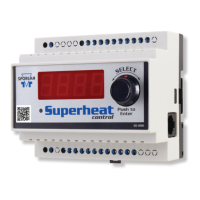Page 6 – Bulletin 100-50-5.1
the EEV to control superheat until the cut-out temperature is
reached. The solenoid valve and EEV will then close until the
temperature rises to the cut-in temperature. Once the valves
close and refrigeration stops, the Superheat Control will
display FF. During refrigeration mode, the controller will
display C. During defrosts, the system master controller
must provide a digital input/short to terminals 27 and 28. The
Superheat Control will close the EEV and display pdn for
pumpdown. A standard dry contact relay can be used. A mini-
mum relay on and off time can be set for the solenoid valve.
See rnt and rF features under the Parameters Section.
CHILLERS AND AIR CONDITIONERS
Superheat control - Single evaporator:
The Superheat Control may be used on single evaporator
chillers or air conditioners. The default control scheme is
optimized for quick pull down (coil temperature) and stable
holding loads. If the controller is used on systems with major
transient conditions (impulse heat loads) it may be necessary
to adjust the PID control scheme parameters. See Section 7 -
PID Tuning.
Superheat control - Dual evaporator:
On some systems, it may be necessary to control two
independent evaporator coils. This setup will consist of a
Superheat Control with display and a Superheat Control
without display. A network must be established between the
two controllers; see Section 6 – Controller Networking. The
display can be used to set up both controllers and to review
parameters from each evaporator coil.
CONTROL FEATURES
Pumpdown
Closing or shorting terminals 27 and 28 (T3) places the con-
troller in pumpdown mode and closes the EEV. A standard
dry contact relay can be used. During pumpdown signal, the
Superheat Control will open terminals 19 and 20 (relay),
which can be used to pilot a solenoid valve or compressor.
During this time, the controller will shut down the control
scheme and prepare for restart. This ensures maximum con-
trol efficiency and system stability.
Manual Valve Positioning
The Superheat Control can be used to manually position the
EEV via a local or remote display. To access manual valve
control, navigate to the Setpoint menu, scroll to SPS and press
the SELECT knob. Once this is selected, the controller no
longer controls the superheat or case temperature setpoint. The
display will show the actual valve position, from 0% to 100%
open once the SELECT knob is pressed. To open the valve,
turn the select button clockwise. To close the valve, turn the
select button counter-clockwise. To end manual valve control,
press the SELECT knob to go back to the Setpoint menu. At
this point, the controller will resume normal operation.
The controller has an internal timeout function and after
60 minutes of inactivity, normal operation will resume. For
troubleshooting purposes, the timeout may be disabled us-
ing the Stepper Timeout Override (Stt) feature. This may
be accessed through the Setpoint menu and placed in the n
position to override the timeout. It should be noted that the
setpoint parameter menu must be exited before changes are
saved. The valve position shown under SPS will blink when
the timeout is disabled.
If manual valve control is needed without viewing system
parameters use the following steps:
1. Through the display, press and hold the SELECT knob
until E PASS appears.
2. Enter “111 ” by turning the knob.
3. Scroll to SPS feature and hold down the SELECT knob
until the position on the display starts blinking (10 sec-
onds). This will override the time out feature.
4. To move the valve, rotate the SELECT knob. The con-
troller will remain in manual mode until the SELECT
knob is pressed.
If manual valve control is needed while viewing system
parameters use the following steps:
1. Through the display, press and hold the SELECT knob
until E PASS appears.
2. Enter “111 ” by turning the knob.
3. Scroll to Stt feature and press SELECT knob.
4. Turn selection to .
5. Push the SELECT knob and scroll to ESC.
6. Press the SELECT knob; the controller is now locked in
manual mode.
7. To manually move the EEV press and hold the SELECT
knob until E PASS appears.
8. Enter “111 ” by turning the knob.
9. Scroll to Sp feature and press SELECT knob.
10. Rotate the knob to move the EEV. The position on the
display is shown % open and will be blinking while in
manual control.
11. To exit manual valve control, use the steps above and
select FF under Stt; exit parameter setpoint menu to
save changes and continue automatic control.
Manual valve control through MODBUS:
1. Enable the feature by writing a 1 to the “Manual Valve
Enabled” coil using the ‘Write Single Coil’ function. See
Appendix J – Modbus Memory Map.
2. Manually move the valve by writing the position, tenths
of a percent, to the “Manual Valve Position” holding reg-
ister using the ‘Write Single Register.’ Each time a write
is sent to the controller, the manual timeout feature resets.
Manual valve control through BACnet:
1. Enable the feature by writing a 1 to the “MANUAL_
VALVE_CONTROL” binary value object’s present value
property. See Appendix K – BACnet Map).
2. Manually move the valve by writing the position, in tenths
of a percent, to the “MANUAL_VALVE_POSITION” ana-
log value object’s present value property. Each time a write
is sent to the controller, the manual timeout feature resets.
NOTE: Use caution and monitor superheat while in manu-
al valve mode. To avoid floodback, start with the valve in a
low position. Never leave the system unattended while in
manual mode.

